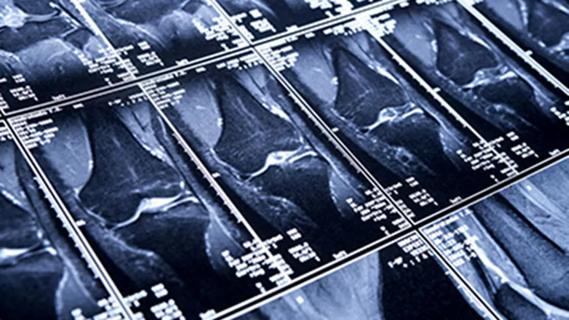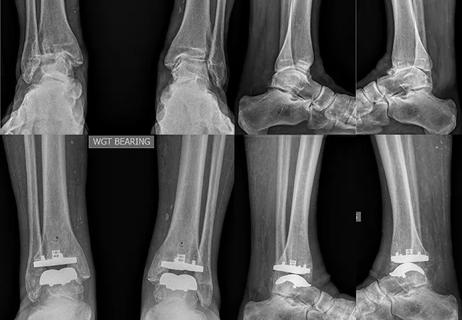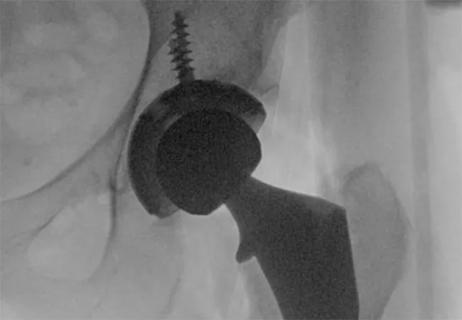A tailored approach combining injections, therapy and preventive care is improving outcomes for patients with elbow OA

Because of its unique structure, elbow osteoarthritis (OA) can be much harder to manage with surgery. Beyond just allowing lateral movement, the elbow’s synovial hinge joint also functions as a pivot joint, as it allows for some rotation of the forearm. Additionally, the elbow has limited soft tissue, which means much less protective covering than a hip or knee. Patients also typically need treatments that are long-lasting and durable, and all of these factors lead to surgery being considered a last resort.
Advertisement
Cleveland Clinic is a non-profit academic medical center. Advertising on our site helps support our mission. We do not endorse non-Cleveland Clinic products or services. Policy
At Cleveland Clinic, Jason Genin, DO, a Staff Physician in the Department of Orthopedic Surgery, says they’ve had success managing elbow OA with several non-surgical options.
“Elbow surgeries are extremely complex, so our focus has really been on exploring every non-surgical option at our disposal,” he says. “We’ve been able to do a lot with brisement, ultrasound-guided injections and immediate post-procedure physical therapy, and we really try to tailor our approach to each patient.”
Dr. Genin explains that when a patient presents with elbow soreness, he looks at stiffness, loss of motion, loss of range and functional capacity to make his diagnosis. “Elbow OA is much more than just something like tennis elbow, where you have good range of motion but some functional issues with activities of daily living [ADLs]. OA is something that’s much more all-encompassing.”
Patients with elbow OA typically fall into a couple of sets, says Dr. Genin. One group consists of patients who have had previous fractures, previous surgeries, injuries, or individuals who are at high risk from sports or other high-intensity activities. Patients with autoimmunities, such as lupus and rheumatoid arthritis, make up the second group. However, the highest indicator of elbow OA risk is family history.
When treating a patient with elbow OA, Dr. Genin says that he typically starts patients with NSAIDs and steroid injections. “At Cleveland Clinic, we’ve taken things a step further, though. We look at pain and function, so even though the steroid injection may help the patient’s pain, it doesn’t support function by reducing stiffness or helping with ADLs. We break it down further and try to categorize our patients as having pain, having loss of function or both.”
Advertisement
For patients with elbow OA who are struggling more with pain, Dr. Genin and his team typically start with a steroid injection. However, they’ve found increased success with using ultrasound to guide the injection and improve accuracy. Being able to guide and deliver the medicine helps maximize its effectiveness and reduce the time between repeat injections.
Dr. Genin also says that with concern about steroid injections and an increased risk of arthritis progression, they are weighing the risks and benefits on a patient-by-patient basis. Additionally, they are also looking closer at using platelet-rich plasma (PRP) injections in similar situations, as well as viscosupplementation.
“Off-label use of visco isn’t typically covered by insurance, so patients will have to pay out-of-pocket, but if there’s stiffness in the joint, this treatment has been well-received by patients,” notes Dr. Genin. “So, whether it's a steroid injection or visco or PRP, it seems like that combination plus the physician and the physical therapy mobility assessment has really been a home run for us, so to speak.”
If loss of range of motion is the primary concern, brisement is considered the next option. While brisement is not typically used outside the world of adhesive capsulitis, Cleveland Clinic has pioneered using brisement for other joints by adding a larger volume of injectate and using physical therapy to work on joint mobility immediately after the procedure.
“This method is something we’ve been doing for the past four years, and it has improved the longevity of the procedure,” says Dr. Genin. “The treatment has given our patients both pain reduction and improved function, which is something we’re very excited about. Previously, we had patients who got a shot of cortisone, which would provide relief for about three months if they were lucky. The brisements last for about a year. That’s something that improves patient satisfaction, and it lessens the burden on the healthcare system because we’re seeing them less frequently.”
Advertisement
Dr. Genin notes that the beauty of approaching care this way is that they view each patient individually rather than following a set order of treatments. He explains that with patients who are diagnosed with arthritis isolated specifically to the elbow and have limited range of motion, he’ll do the brisement first before adding therapy on the back end.
“We feel like the mobility is better after the procedure, so the improved range of motion helps make therapy more tolerable,” says Dr. Genin. “A more tolerable therapy session means a more positive experience for the patient, which means they’re typically able to get more out of it.”
For patients who have an elevated risk of elbow OA, Dr. Genin says that there are steps patients can take to help reduce that risk. Maintaining healthy habits is something he and his team always look at and discuss with patients. For patients with obesity, diabetes, hyperlipidemia, cholesterol and hyperlipidemia, this can be especially impactful.
If there are modifiable steps, we want to modify those where we can,” explains Dr. Genin. “Even though the elbow isn’t a weight-bearing joint, it’s still important to have good muscle strength there. A lot of folks really underestimate the amount of time it takes and the time it takes to get good muscle strength, but it really does correlate to an overall stability of the joints. We see too many who don't lift or don't strength train. Cardiovascular is an important part of being healthy, but so is weight training. That’s been something we’ve tried to get across more, and I think adding the therapy side-by-side at the time of procedure has been another way we can help get that point across.”
Advertisement
Additionally, he mentions that while products like glucosamine and chondroitin won’t reverse arthritic effects, they may slow progression. He also says that his team has been happy with what they’ve seen with collagen supplementation and amino acid blends.
“Not every patient needs to take these products, and again, these products won’t reverse arthritis, but they may help slow the rate of it,” explains Dr. Genin. “At the end of the day, the best way patients can be proactive is if they feel like something isn’t right, they should seek care immediately rather than letting this pain go on for years and allowing it to progress.”
Advertisement
Advertisement

Center will coordinate, interpret and archive imaging data for all multicenter trials conducted by the foundation’s Osteoarthritis Clinical Trial Network

Cleveland Clinic radiation oncologists aim to bring the noninvasive approach back to the U.S., where use has declined

How year-round play and cold weather impact young throwers — and what can be done to protect them

Clinical complexity demands personalized care strategies

Despite rising injuries, the trend towards personalized care is improving treatment approaches

Rest is often not the best care for gamers’ overuse injuries

Arthrodesis is not the only surgical option

How it actually compares to posterior and lateral approaches